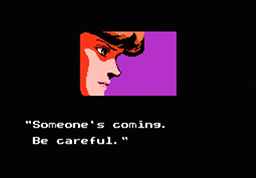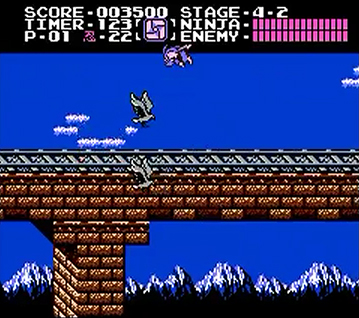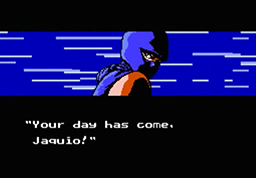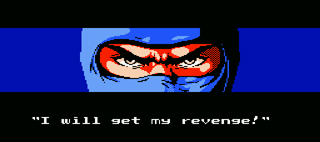
Ninja Gaiden
- Tecmo, 1989 -
SCORE: 80 out of 100
SUGGESTED PLAY, BUT DIFFICULT! Classic, Tecmo remake of a forgettable arcade title that introduced cinematic cutscenes; its graphics, soundtrack and story encouraged many to forge forward through infamous difficulty
[REVIEW|+ VS. -|IF YOU LIKE...|SECRETS & TIPS|FINAL SCORE|BREAKDOWN|MISCELLANEA]
Delights... Camera... ACTION!
Tecmo's first take on the action, ninja craze of the 1980s was its arcade release, Ninja Gaiden. But, for its second take, Ryu Hayabusa's tale of revenge is reinvented on the NES as an innovative reimagining with animated cut-scenes and stellar production. But, does it make the cut?
Tecmo's directorial debut, Ninja Gaiden, showcases a slice of the silver screen, while bringing a whole new meaning to the word, stage. By taking your everyday, run-of-the-mill, quarter-engulfing, arcade fare (which the arcade version of Ninja Gaiden essentially was, with its multitude of cloned, horror villain, Jason Voorhes, from Friday The 13th), and totally reimagining it with its patented "Cinema Display (TECMO'S unique system)," Ninja Gaiden crushed conventions of what action gaming could be in the late 1980s, and forever forward. (Interestingly enough, the game was re-rebooted in 2004 for the Microsoft XBox with an insane degree of difficulty... yes, even more difficult than this title [Read more to find out the details.])
Ninja Gaiden is an engrossing tale, finessed with an awe-inspiring, cinematic flair. Referred to as one of the "Tecmo Theater Games" in its manual, Ninja Gaiden is presented in Acts with new storyline scenes being spliced between stages, motivating the player to advance. The story is rife with intrigue and mystery, and features a curious mix of characters — a mysterious woman on your trail named Irene Lew; shifty CIA agent, Foster; and a larger-than-life antagonist, Guardia le mieux, better known as the Jaquio.

Meet the star of the show — YOU as Ryu Hayabusa!
But, the true genius in this title is its original use of cinematic techniques that play out like the commands one might hear barked out from the director's chair — wipes, pans, cuts and tilts — punctuated by a memorable score and dead-on musical cues. Its script leaps from the designer's storyboards and comes alive from the opening scene that depicts a fateful meeting of dueling ninjas.
From just that single viewing of the game's Prologue, the player realizes that he/she is witnessing something special and becomes transfixed, sitting back, watching intently with popcorn in hand. But, wait... there's no time for the casual, uninvolved spectator! To actually see where this story goes, you must become an active participant and serve as the star of the show, assuming the role of leading man, Ryu Hayabusa — ninja extraordinaire, outfitted in midnight blue cowl and scarf, heir to the otherworldly "Dragon sword of the Hayabusa clan."
Perhaps unwittingly getting yourself into a role that may not be quite as fun as it seems from the relatively-innocuous start at Galesburg and Jay's Bar, Ryu's journey for exacting vengeance for his slain father will lead him to the Americas.
The earliest levels let you feel your way through a city street, perfecting the esoteric Ninja arts of the "Wall-Spring Jump" and "Wall-Spring Climbing Jump" (similar to Capcom's NES version of Strider, but much easier to perform) [See Secrets & Tips Section below to learn more about these jump techniques.], scaling buildings and clinging onto neon signage that looks conspicuously like a certain worldwide, carbonated drink's logo. In between your lessons, you begin attaining mastery of your sword, slashing lowly street thugs, recruited boxers and other dimwitted enemies with precision and ease — all the while, being lulled into a false sense of ease and easy-going by the sluggish main boss in Jay's Bar, Barbarian, who lethargically drags his ax. So far, so good. No bottomless pits, tough jumps to complete or complicated, combat patterns to recognize.

Irene Lew doesn't appreciate Ryu's sexist remark, as she displays her disapproval with a show of Girl power!
Then, suddenly, a mysterious woman appears in the bar and snaps you and Ryu out of the malaise with whiplash-like effect. Before you know it, Ryu (and you) are startled by the crack of gunfire, and from this point forth, you launch from the starting block, ready to make your way through the 20 grueling stages that cover the game's six Acts.
Just when you thought you had a sure footing on things in Galesburg and Jay's Bar, the game's levels increasingly become more and more treacherous. With less terra firma, and just plain more terror, the cautionary, yellow-and-black striped, construction zone of the Outpost, and the perilous drops of the aptly-titled Death Valley, where crumbling, concrete walkways and supports (stone pillars à la Rygar — another of Tecmo's games — and Castlevania by Konami) somehow defy logic and gravity, reveal hints of the troubles ahead.
Crystal Lake (once again, Tecmo seems fixated on the Friday The 13th series) is where you first make acquaintance with one of the Nintendo era's most maligned and hated, minor enemies — the swooping birds. Learning to dodge the hail of birds homing in on Ryu, as you play hopscotch over staircase-like piers, lined with missing clusters of planks, will serve you well, preparing you for later levels that are much-less forgiving.
Once you overcome the anything-but-calm waters of Crystal Lake, Ryu's pursuit will lead him, inexplicably, into the snowy passages of Lizard Mountains (reminiscent of Contra's Snow Field), where armed soldiers stand between our hero and the toughest member of Jaquio's "Malice Four" yet — Basaquer.


Ninja Gaiden's pixel-perfect portraits and multilayered landscapes still stand up today.
Next up, the Lizard Mountains stage continues the grueling training of learning to nimbly navigate precarious paths and dodge deadly falls at a high-tempo — essential skills for learning to endure and persevere through the later levels. But, don't forget to take some time along the way to admire some of the finest 8-bit artwork seen on the NES — from the exquisitely-detailed, wizened features of archaeologist and old friend of Ryu's father, Walter Smith, to the breathtaking vantage point found in the South American Amazon level.
From this point on, the game takes a harsh turn off into tales of demon statues, and corkscrews into an even more brutal level of challenge. Ryu's journey will have him venturing through such lovely haunts, as the Hall Of Demons (perfectly capped by the paranoia-inducing, The Twilight Zone-themed soundtrack in this grim level, guarded by Jaquio's pet dog, Kelbeross [See Secrets & Tips Section below to learn how to pass Kelbeross]); the bleak Prison Of The Dead (deep depths reminiscent of Castlevania again... the deep plummet that Simon Belmont takes at the end of the third stage is paralleled by Ryu here); the acrophobic Cliff and Nails Of Lukifell (where cliff-diving can quickly become an unfortunate sport, or unwanted and forced choice of habit [See Secrets & Tips Section below to pass the near-impossible jump near the end of 5-2]); and the maddening climax with Bloody Malth, as he summons lightning to vaporize Ryu at the Place Of Red Execution.

Bloody Malth is the final member of Jaquio's "Malice Four," and proves to be the most worthy competitor of the pack.
The last level consists of crossing the Death Bridge (6-1) to enter the Temple Of Darkness. Once there, the climb through the enraging Hall Of Brahmans (6-2) and the condemning Hall Of Judgement (6-3) is a torturous gauntlet of unrelenting wrath... only to be capped off by The Black Throne, where not one, not two... but three consecutive main enemy fights sandwiched between momentous acts await you.
Upon failure to beat any one of these adversaries, Ryu will be ejected back to the start of the lowest story of 6-2. This is when Ninja Gaiden reveals why it induces more nightmares with birds and vertigo than Hitchcock ... if you can weather the waves of dive-bombing birds and spasmodic respawning of enemies (especially above the bottomless pits), and can temper (pardon the pun) the tempest of rage that will set in on these final levels and during the main battles, consider yourself a true gamer. Patience, memorization of enemy attacks and spawnings, and the boldness and bravery to forge forward without hesitation and with reckless abandon in many cases, is key.

What's a great film without a larger-than-life villain? In the case of Ninja Gaiden, it is Jaquio.
Be forewarned, Ninja Gaiden will test you like few others. Jaquio; his pet dog, Kelbeross; and the "Malice Four" — Jaquio's crew of "killer B's" (Barbarian, Bomberhead, Basaquer, Bloody Malth) will stand in Ryu's way, no doubt, but the real challenge is actually being able to pass through the stages to reach these major bosses.
The stages are crawling with a motley crew of crazed henchmen, ranging from what appears to be football players (seemingly misplaced or lost from Tecmo Bowl - its signature football title of the time), mutated figures and ghastly wraiths to beady-eyed bats that are nearly undetectable, until an ill-timed jump; big cats leaping over ledges and those aforementioned kamikaze-crazed birds shrieking by.
It's not the quantity of foes, though, that makes Ninja Gaiden so difficult; it is the tricky patterns and nonstop respawnings, especially over pits that must be perfected. A majority of the game's malevolent menaces materializing out of the ether, especially in the final stages, seem hellbent on ricocheting Ryu into the great unknown without a safety net.

Perhaps the understatement of the year!
With each of these stinging stoppages in the action, the crackled shell of the most composed gamer begins to give way. To further intensify the angst, the fast tempo soundtrack ticks down at a break-neck pace, like a fuse burning down to the bomb, subconsciously boring into the player's mind.
To overcome Ninja Gaiden, one has to quiet the environment. One has to quickly regroup and let go of the aggravation that can and will consume you; one's mettle must reach a zen-like state to let go and march forward, or else one will be doomed trying to exact vengeance. (Like Battletoads, memorization of the patterns of enemy attacks and power-ups under high-speed, pressurized gameplay is imperative.)
You must quickly become a convert and true-believer of the adage, "Look before you leap." Each jump is a split-second deathtrap, so the player must learn to make precalculated moves, almost like chess, to lure out the would-be perpetrators.

Ninja Gaiden's unforgiving learning curve and difficulty can make this game feel like it's for the birds.
On the upside, Ninja Gaiden isn't all gloom and doom; the game does throw Ryu a few bones, with perhaps the biggest gift coming in the form of unlimited continues. Even with this gracious gift, though, the most worthy ninja will wish for more, as he/she will undoubtedly, rotate through several just to catch a glimmer of hope of ever revealing the game's climactic ending.
The other nod of sympathy that the programmers and designers share comes in the form of power-up items that appear at regular intervals across the game's many stages. Konami's Castlevania hid its power-ups in candles in much the same manner; however, candles are swapped out for lanterns, lamps, birds, spiders, dragonflies and sundry other objects in Ninja Gaiden.
Ninja Gaiden's power-ups include:
- Throwing Star
- Windmill Throwing Star
- The Art Of The Fire Wheel (with its upward arc that scorches all evil within its path)
- Jump & Slash Technique (similar to Samus Aran's Screw Attack from Metroid, this powerful weapon in particular, can easily eliminate almost any enemy — including main enemies! — in just one whirling attack! Also, it can be argued that the Jump & Slash Technique served as a very strong, inspirational impetus for the 2004 hack-and-slash reboot of Ninja Gaiden. [See Secrets & Tips Section for more.])
- Invincible Fire-Wheel
- Time Freeze
- Restoring Physical Strength (partial energy refill) [Learn how to get multiple ones quickly here.]
- and even the invaluable 1UP!
(Note: When you possess a power-up item, be sure to hold ▼ when you stab with your sword, so as to not accidentally use the special attack when unwanted.)
The special weapons that Ryu finds are powered by Spiritual Strength (the red is worth 10 points, while the blue is 5 points) and cost a different amount of points per usage. (Note that the Invincible Fire-Wheel costs no Spiritual Strength, but can be only used once and disappears after its timer ticks down, leaving no weapons behind once it vanishes. Also, note that the Time Freeze does not cost any Spiritual Strength points either, however, other special power-up weapons can be used, while time is frozen!)
Castlevania's candles aren't the only flames of inspiration that Ninja Gaiden gleaned from the classic title; several other aspects of Castlevania served as a fitting muse for Tecmo's development and design team. The team at Tecmo traced the template of Konami's model, and filled it in with a motif of ninjas, vengeance, the C.I.A. and demons, completing it with a flourish of cinematic might. Take a closer look, beneath the surface below:
RETURN TO IF YOU LIKE NINJA GAIDEN... SECTION BELOW
RETURN TO CASTLEVANIA REVIEW
It is true that the movie-like feel (seen especially in the ending) of Castlevania has been absorbed and illuminated throughout Ninja Gaiden. However, it cannot be understated that although Tecmo found much inspiration, they still created a wholly-new experience and a masterpiece that stands on its own. Tecmo proved that an 8-Bit medium could tell a strong story and could creatively convey plot through beautiful graphics and music.
Ninja Gaiden left an indelible stamp on the gaming world, much like the etched dragon carving on Ryu's blade. Its theatrical aspirations were so great that it spawned many imitators, but inferior games with lesser efforts and expertise could never reach or capture that same level of magic found in this "Tecmo Theatre Game."
Tecmo's superior effort was so good that it left little for the cutting-room floor, with the exception of some content that Nintendo's stringent censorship policy of the day may have deemed objectionable. Its demonic backstory may have cast a long, dark shadow that probably had Nintendo's censors clamoring, and it is conceivable that Tecmo's developers nervously buckled, adding a geometric point to the notorious shape that is prominently-displayed in 6-2 (Hall Of Brahmans), 6-3 (Hall Of Judgement), 6-4 (The Black Throne) and on Jaquio's garments to form a safer hexagram as an acceptable symbol instead.

You will feel all of Ryu's rage by the time you reach Jaquio — if you reach Jaquio.
One can speculate that other questionable ideas that may have been covered up or glossed over, could be found in the redesigned soda logos on the signs of Galesburg, and in the names, Kelbeross (very similar to Cerberus, the mythological three-headed dog that guarded Hades) and, especially, the Nails of Lukifell (where the name "Lukifell" might just be an altered form of the name, Lucifer, where the letters "k" and "l" were switched out for "c" and "r" respectively).
In closing, this stunning debut by Tecmo presents a director's cut that is as sharp as the steely edge of Ryu's Dragon Sword's blade. This cinematic sensation sparked a generation of game designers and players alike, and incited a number of them to skip that Filmmaking 101 course, and to sign up, instead, for the marathon of mettle and might that was/is Ninja Gaiden. Ninja Gaiden is a study in excellence, just bear in mind that you'll need several rehearsals to nail this part!
b. jones © 2015
If you like Ninja Gaiden, perhaps you would like these titles:
- Castlevania [NES]
- Shinobi [GEN]
(similar arcade platformer feel and ninja as main character)
- Rygar [NES]
(another title by Tecmo in same era)
- Ninja Gaiden II: The Dark Sword Of Chaos [NES]
Ninja Gaiden III: The Ancient Ship Of Doom [NES]
(direct descendants and continuation of overall story)
- Ninja Gaiden [XBox] and other Ninja Gaiden titles [Playstation, etc.]
(continuation and legacy-builders, loosely-related and built upon)
- Contra [NES]
(similar pace of action with some inspiration of design)
- The Messenger [Nintendo Switch, PS4, Xbox, Steam (PC), gog.com, Epic Games, Microsoft]
(a modern title taking heavy visual and gameplay inspiration from the NES classic)
- Bot Gaiden [Steam (PC), Nintendo Switch, PS4, Xbox Series X, Xbox One]
(a modern take that is heavily-inspired by the NES classic with robotic counterparts, names and hand-drawn platforming that are very similar)
(very influential and extremely similar in a number of ways [see table in review])
Secrets & Tips for Ninja Gaiden |
|
|---|---|
| SOUND TEST |
Ninja Gaiden boasts one of the NES' premier soundtracks. It's so good that Tecmo decided to dedicate a special code to allow audiophiles to access the composers' score (More Yamasan, B. B and Hakage) without all of the distractions and aggravations of actually having to fight through the game. Enjoy! RETURN TO BREAKDOWN AND SPECS PAGE OF NINJA GAIDEN |
| MULTIPLE 1UP's AND RESTORING PHYSICAL STRENGTH | It goes without saying, Ninja Gaiden is easily one of the most challenging games of the NES era. Power-ups can only take you so far in some of the later stages of this punisher; having additional 1UP's to help pass some points before the dreaded continue drops you back to the start of a stage, may just get you over the edge. Check out the area below where the 1UP can be repeatedly gotten. [NOTE: A maximum of 9 players in reserve can be collected. Also, note that you must exit the screen by going down the ladder and return to get the 1UP to respawn.]: 5-3, Third Floor (1UP): Losing energy from the swarming attacks of enemies in Ninja Gaiden may seem demoralizing, but in a few areas in the game, you can boost your morale and chances by filling and refilling up on Restoring Physical Strength potions. Check out the areas below where the Restoring Physical Strength potions can be repeatedly gotten. [NOTE: You must exit the screen by going down the ladder and returning to get the Restoring Physical Strength potions to respawn.]: 5-2, Fourth Floor (Restoring Physical Strength): 6-2, Fifth Floor (Restoring Physical Strength): 6-3, Fourth Floor (Restoring Physical Strength): RETURN TO REVIEW - RESTORING PHYSICAL STRENGTH POWER UPS SECTION |
| GETTING PAST THE CLIFF AT STAGE 5-2 | There is a point in Ninja Gaiden that seems impossible to pass. That deceptively-devastating point lies in a suspended cliff that blocks the way on the fourth floor of the stage. At first glance, it seems impassable, but as seen below in the illustration, there are actually 2 ways to traverse the hindrance. [Note: It will probably take some practice to learn both routes, but once you do, Ryu will be able to march forth.] Route 1: Simply lightly jump, or carefully walk off of the ledge and pull back, so that Ryu attaches to the bottom reaches of it. Next, jump across the bottom side of the cliff and land on the platform below. Route 2: This technique capitalizes on a glitch in the programming that allows Ryu to pass through stone. It should be stated that some damage will occur from the bird that appears in the screen, but if your jumps are timed precisely, you should be able to take minimal damage and you should be able to land safely on the platform below the cliff. To attempt this route, jump from the ledge you're standing on, and try to cling to the highest point of the cliff above. Now try to quickly jump and re-attach to the wall, as you climb higher and higher. Once you reach its highest point, Ryu will fall through the cliff and should land on the platform below. Again, take care to try to dodge the bird as much as possible.  RETURN TO REVIEW - CLIFF AND NAILS OF LUKIFELL SECTION |
| THE TRUE POWER OF THE JUMP & SLASH TECHNIQUE |
Once you have obtained it, if you can avoid opening candles, etc. that hold other weapons, the Jump & Slash Technique will prove worthy of the effort for it is the one item that can kill almost every main enemy in the game with only one or two uses maximum - easily erasing between 12 and 16 enemy energy bars in a single slash! It can be tricky to hold on to, but even in tough sections of the game's regular stages, this power-up makes Ryu virtually invincible when it is in use and can effectively eliminate all foes within Ryu's leaping reach. NOTE: To avoid accidentally wasting Jump & Slash Techniques as you race through a stage, simply hold ▼ while using your regular sword attack. This will stop the automatic usage of the item and draining of your Spiritual Strength reserves. RETURN TO REVIEW - JUMP & SLASH TECHNIQUE POWER UPS SECTION |
| WALL-SPRING JUMP AND WALL-SPRING CLIMBING JUMP TIPS | Instead of rapidly tapping A to jump back and forth between walls, if the player holds down on A and shifts the directional pad back and forth, it is easier to perform. RETURN TO REVIEW - WALL-SPRING AND WALL-SPRING CLIMBING JUMP SECTION |
| SAFE ZONE WHILE FIGHTING KELBEROSS | Jaquio's pet dog, Kelbeross, guards the path at Stage 4-4 that eventually leads the way to the Temple Of Darkness — a very similar parallel to Cerberus, the three-headed dog that guards Hades in Greek mythology. Two Kelbeross appear and bounce from the walls and floor, spitting forth deadly globules, making for a frantic battle with little room for dodging and/or mistakes. However, there is a relatively safe space hidden within the room where Kelbeross rarely invade (Notice that they rarely invade, meaning that they don't always enter the space, but they can and might at times, so stay alert!). Standing within the left pillar — the one set aglow in white in the illustration below — provides the buffer zone for Ryu to stage his attack.  |
FUTURE ADVERTISEMENT PLACEHOLDER.
This area will feature a rotating banner for advertisements.

If you'd like to advertise on our site, please contact us here. Think big, dream bigger!
CONTACT & SOCIAL MEDIA.
We are interested in what our visitors have to say. Please click here to share/e-mail any comments,
suggestions or feedback.
Being the social butterfly that we are, you can like us on Facebook, follow us on Twitter and Pinterest, and watch our video list on YouTube! (Soon, we'll be adding a blog with polls.)



















 The Jump & Slash Technique power-up is the most powerful weapon found in Ninja Gaiden. It's not found in every stage, and when it is present, it is usually found near the beginning or bottom of a long stage.
The Jump & Slash Technique power-up is the most powerful weapon found in Ninja Gaiden. It's not found in every stage, and when it is present, it is usually found near the beginning or bottom of a long stage.



